The Bay Trail Preview: Intel Atom Z3770 Tested
by Anand Lal Shimpi & Brian Klug on September 11, 2013 12:00 PM ESTIn addition to showing Bay Trail running on a Windows 8.x platform, Intel showed us a “pre-beta” version of the platform running Android 4.2.2. I have to emphasize that the build they showed us definitely seemed pre-beta, as there was some instability, but overall the build was good enough to run some tests on and get a feel for. Intel made it clear that they do have a lot more work to do on their Android build before it’s considered close to final quality than the Windows equivalent.
Inside Android we can still see the CPU state table data and how long the cores are sitting in each performance state still, despite this now being managed in-silicon on Bay Trail. In addition Android sees the 2.39 GHz Z3770 boost frequency and reports it. I didn’t see any strange behavior on the device while running tests and watching CPU frequency, if anything the reference design platform stayed at the maximum boost frequency even with four cores plugged in for an impressive amount of time. Of course this is a tablet so there’s more TDP to play around with compared to a phone.
Depending on where you were in the Android UI, there was some definite stutter, but I’m told this is a result of an issue with Dalvik not allocating threads to cores properly that Intel is still tuning, something which you can see plays itself out as well in the AndEBench Java test that runs in Dalvik. The launcher especially had some stutter, but Intel claimed they were aware of it and that final performance in areas like that would be dramatically improved. Regardless of the state of Bay Trail’s Android port, it affords us the opportunity to look at performance through our pretty standard benchmark suite.
On the CPU side for Android we’re still limited to just a few tests that rely on a combination of native code and stuff that runs inside the browser. That means AndEBench, JavaScript benchmarks, and part of Vellamo.
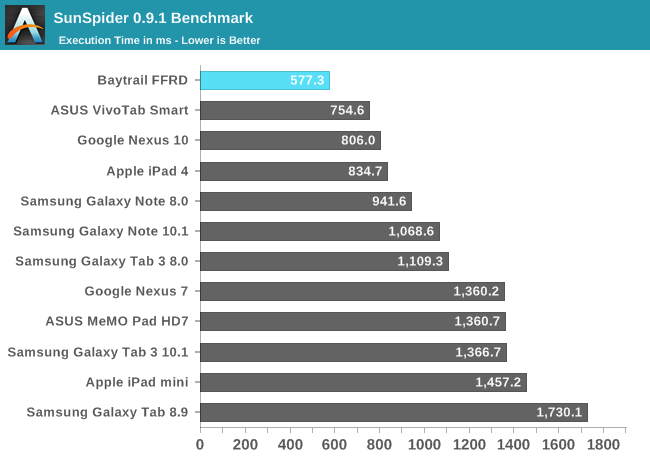
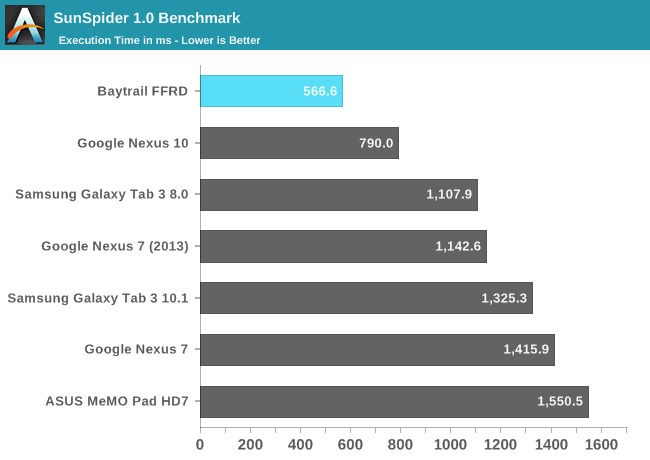
Sunspider has been a regular staple but in recent time has become an exercise in browser JavaScript engine optimization rather than actual performance. Nevertheless the FFRD takes the crown in both 1.0 and 0.9.1 (we have more tablet data from the 0.9.1 version so I replicated it here).
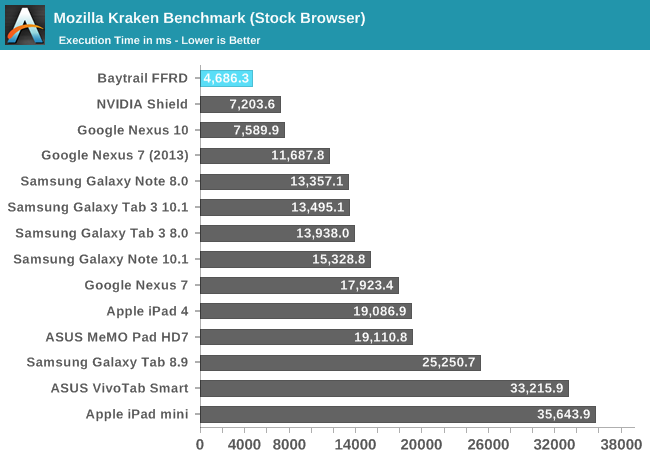
Kraken is another JavaScript benchmark which hasn’t quite been an optimization target everyone has gone after lately, and it’s also longer, which makes it a bit more reliable. Once again Bay Trail takes the crown here with notably faster JS engine performance.
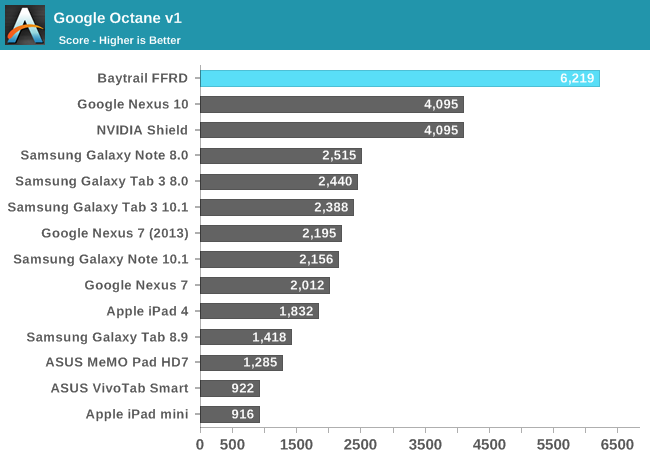
Google Octane is another JS test that isn’t quite as platform optimized yet, here there’s once again dominance by Bay Trail with just over a 50 percent higher score.
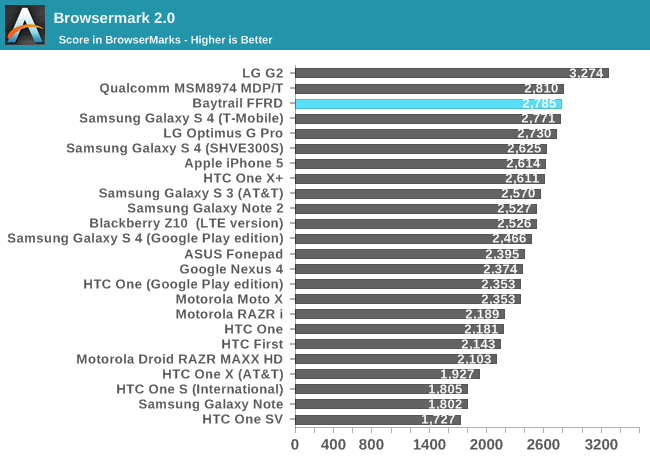
Browsermark has a combination of both JS tests and other web related performance metrics. Here the Bay Trail platform lags behind the 8974 based devices slightly. This isn’t a raw JavaScript benchmark again but rather a more holistic web browsing performance test, so it’s interesting to see Bay Trail a bit behind here.
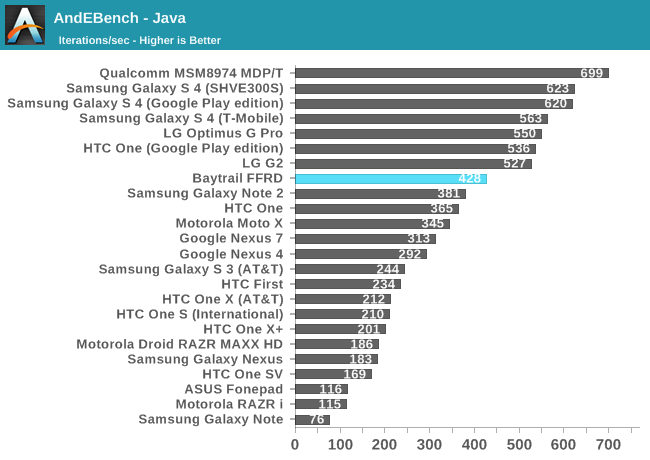

AndEBench is a combination native compiled microkernel benchmark (indicative of NDK application performance) that also runs a very similar workload atop Dalvik like a normal Android Java application. Here we can see what Intel was talking about when they said they have more work to do getting Dalvik working properly at dispatching threads to appropriate cores, hopefully the Java number will climb considerably. The native test also shows a lead over the competition.
GPU Performance
While Bay Trail clearly leads on the CPU side, its GPU performance is more middle of the road - at least among the higher end SoCs. In 3DMark Bay Trail's GPU performance is aided by the more CPU bound nature of the benchmark, but here Intel is able to beat the Snapdragon 600. Snapdragon 800 on the other hand pulls ahead by around 35%.
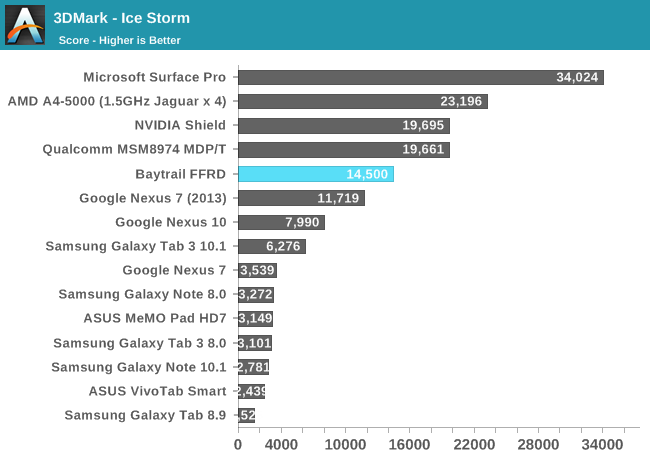
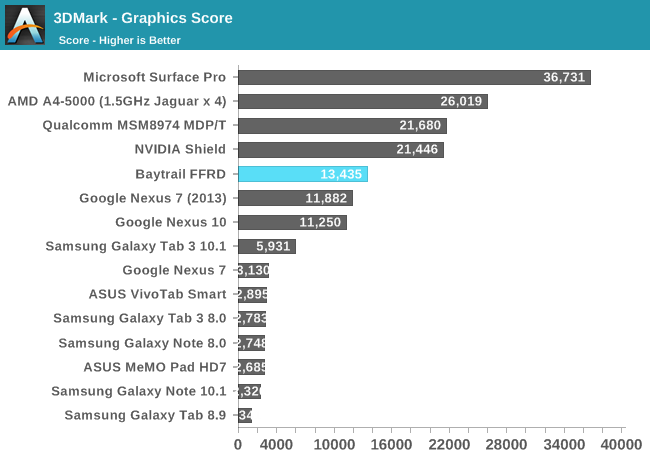
The 3DMark Physics test is effectively a CPU test, which once again plays to Bay Trail's strengths. Here it's faster than Snapdragon 800 and Cortex A15. Only Ivy Bridge is quicker in a tablet.
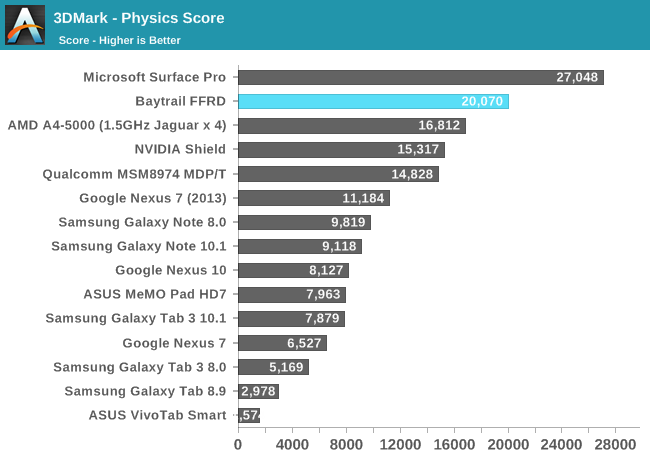
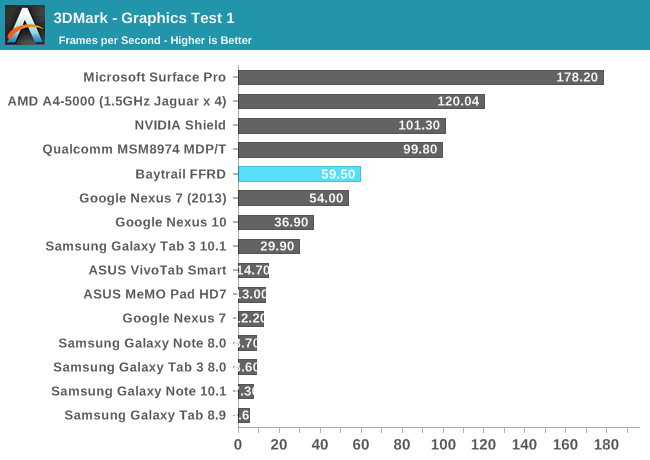
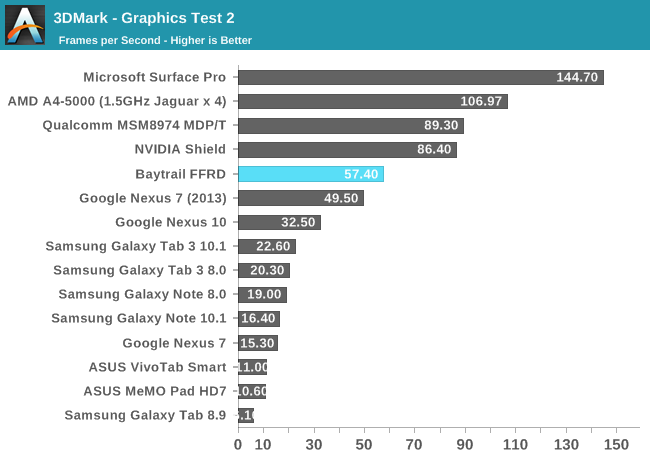
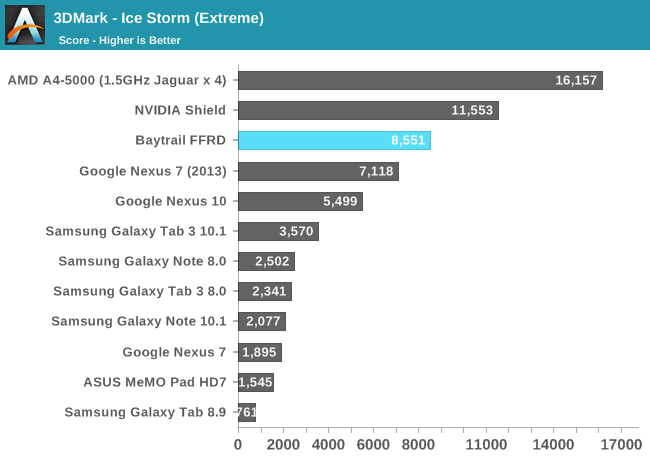
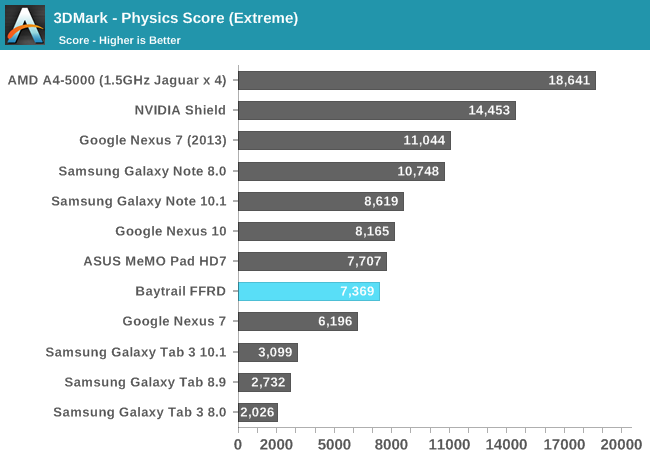
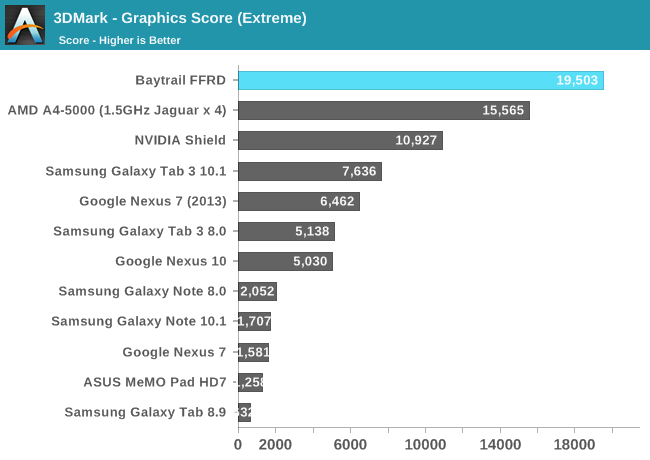
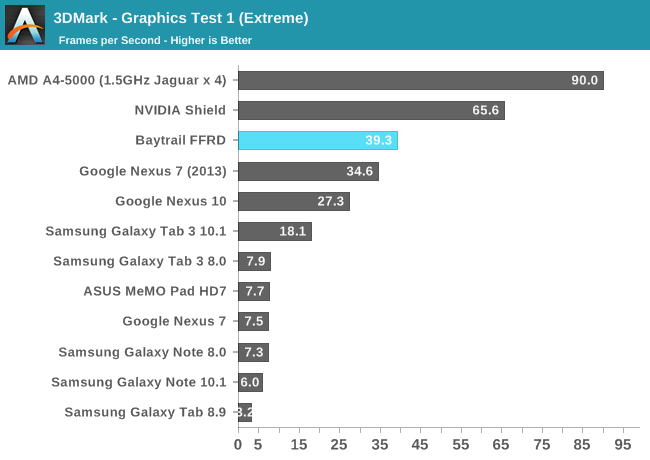
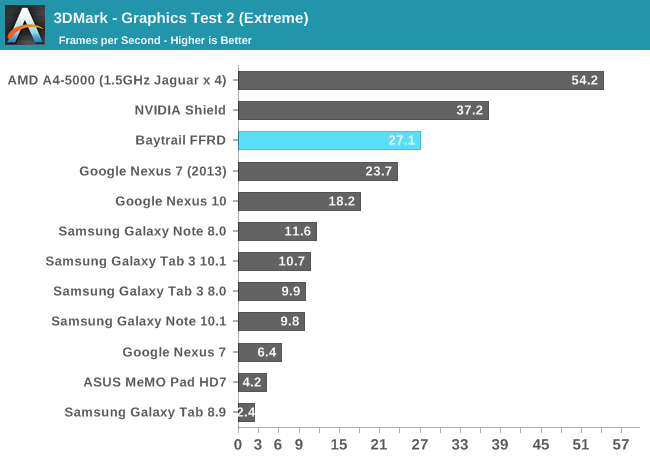
Basemark X
Basemark X is a bit more GPU bound than 3DMark, and we also have iOS data here so we can put Bay Trail's performance in better perspective. Here Bay Trail is a bit slower than the iPad 4, and clearly Tegra 4 and Snapdragon 800. Intel's GPU in Android is measurably quicker than Adreno 320/S600 though.
Bay Trail's onscreen performance is penalized by the FFRD's extremely high native resolution.

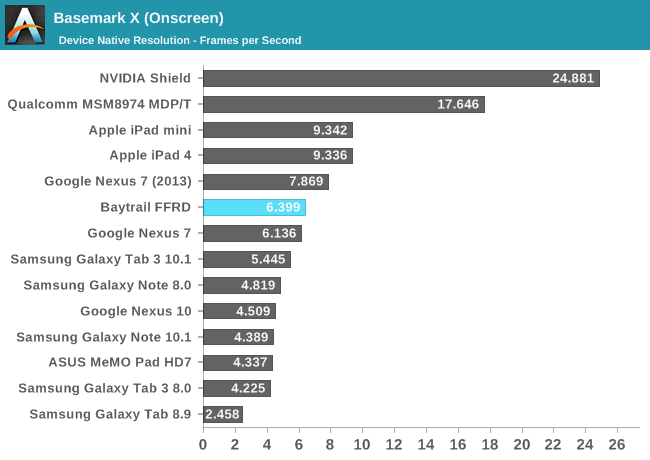
GLBenchmark 2.7
The more interested GLBenchmark numbers, T-Rex HD, show Bay Trail just behind the iPad 4 in performance. It's definitely not bad at all but clearly not industry leading.
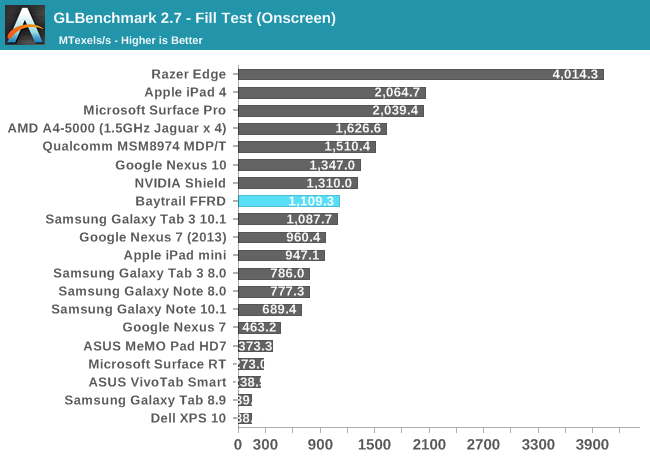
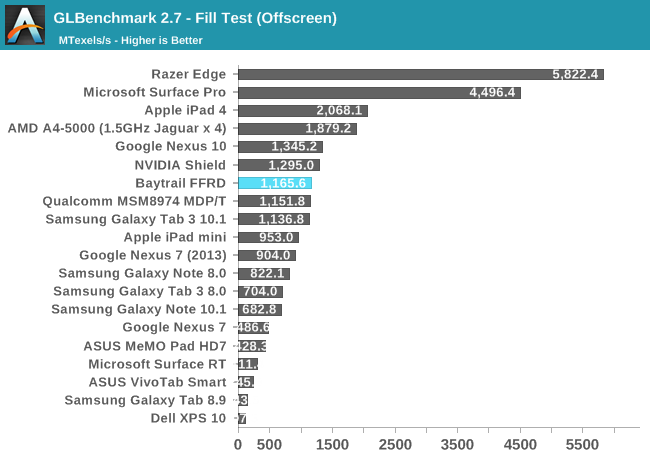
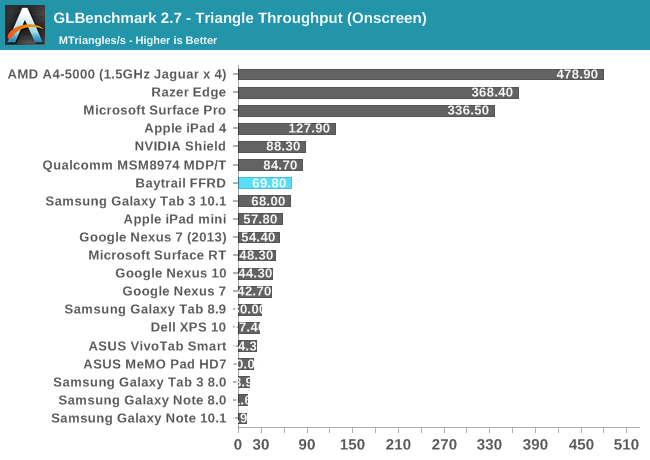
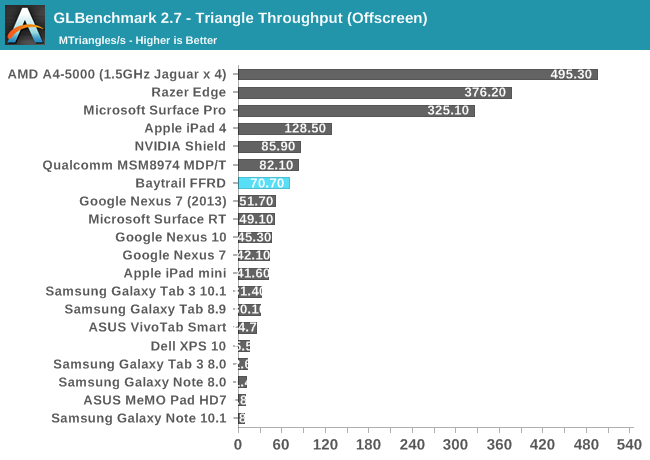
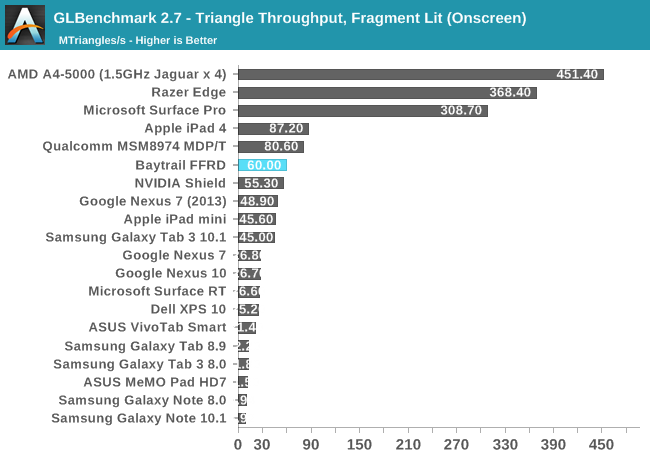
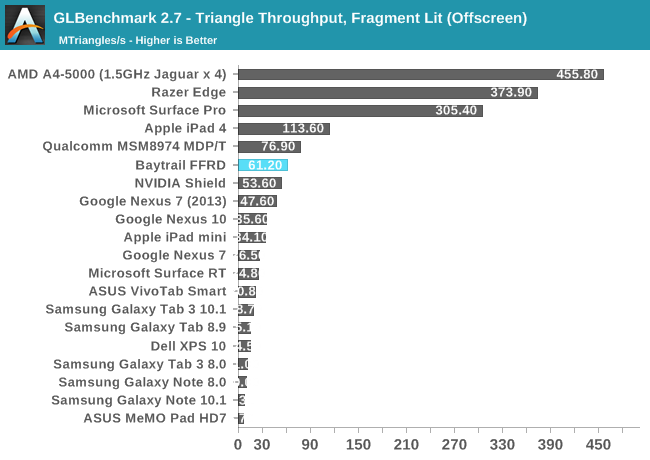
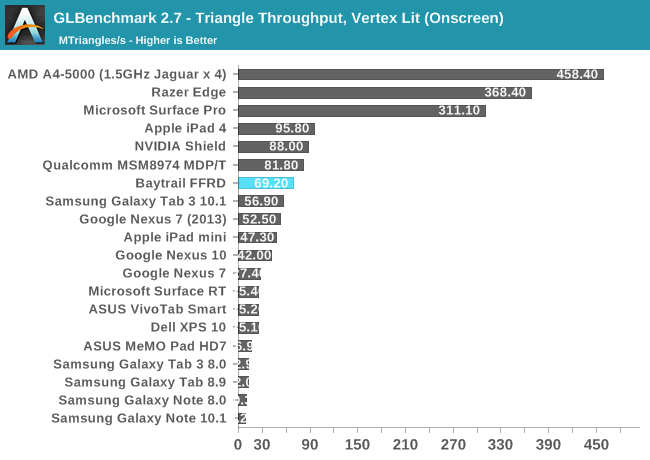
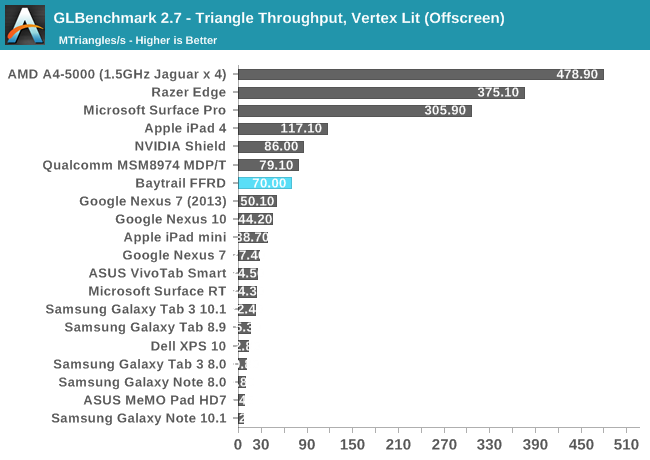
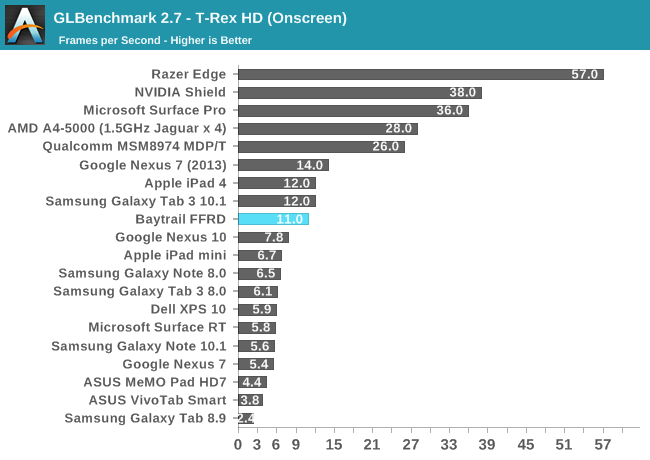
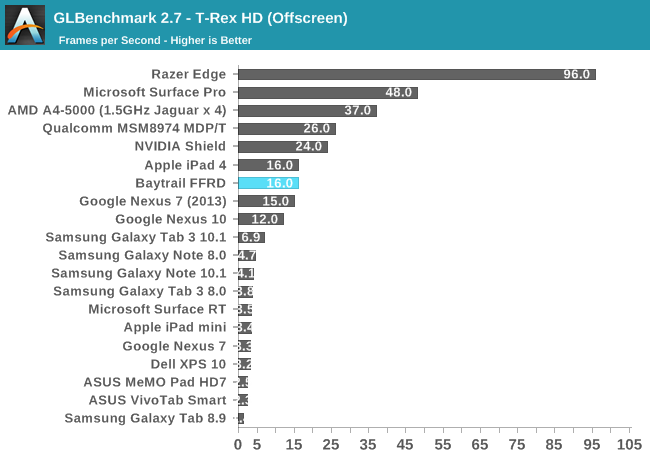
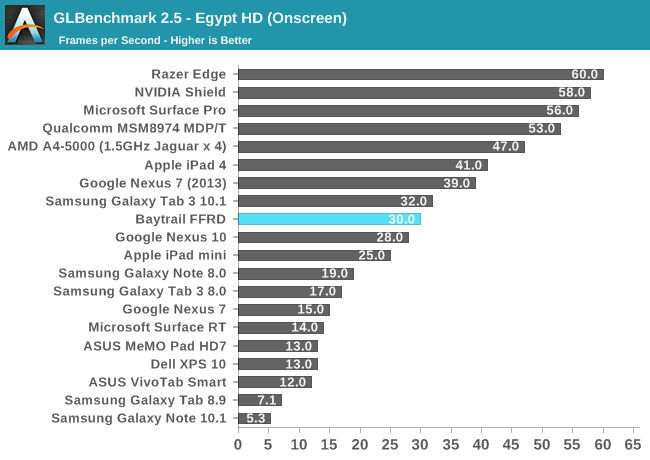
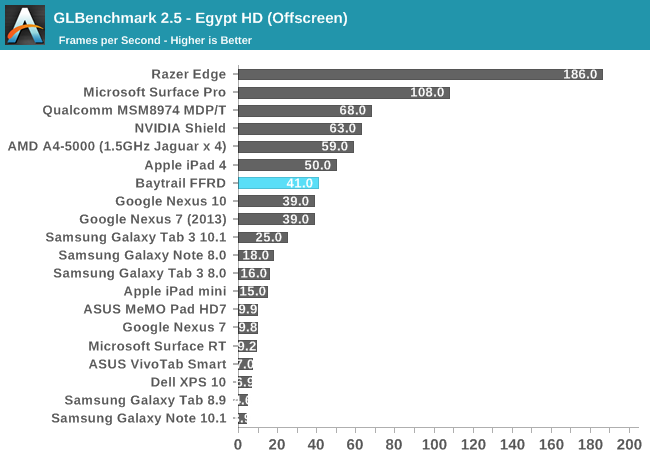
















190 Comments
View All Comments
Speedfriend - Thursday, September 12, 2013 - link
"And on GPU, it concluded with " Intel's HD graphics in Bay Trail appear to be similar in performance to the PowerVR SGX 554MP4 in the iPad 4" I mean unless you are interpreting the results much more differently then what i read i the graph. Then please do explain yourself there. Because I dont read how it is "similar". There are like at least 20% of performance difference."In T-Rex offscreen, it equals the iPad4, so I would say he is correct, but off course T4 and Adreno 330 are significantly ahead. Intel have probably realised that most consumers don't know or care what graphics are in their tablet/phone and are sold on core and Mhz.
What people don't seem to realise is how strong the Intel inside argument will be in tablet sales, given they will mostly be bought in computer store alongside laptops. No consumer has any idea who ARM or Qualcomm are.
monstercameron - Friday, September 13, 2013 - link
I dont but the mhz/core argument, besides apple has shown -for 3 generations now- that cpu performance doesnt matter, the gpu is where it is at. Just look at the tegra 3 and apple a6x.JPForums - Thursday, September 12, 2013 - link
Or, ya know, he only had a couple of hours with the platform including install time. You might get a more in depth look once devices hit the labs.
He only had a couple of hours to test. I'm pretty sure new iPad wasn't launch in this time frame. When the new iPad is launched, I suspect, based on past experience, that Anand and his associates will test it and compare it to the other products available to them at that time. Throwing a little tid bit of what is to come based on information you already possess is fine and dandy, but you don't want to mix speculation with your actual performance comparisons.
The only way to compare this to the up coming A7X in a relevant manner is to wait until it comes out. However, there will always be a newer potentially better product coming out "soon". Then he really would have to show a bias in choosing which new product to launch the article around. Furthermore, he would deprive his readers of the information he has now.
The data is presented in an easy to read fashion so that you can come to your own conclusions, even if they conflict with his. This shows that he assumes that (at least some of) his reader are capable of analyzing data and making informed conclusion based on it. For instance, there has been mention of the soon to be released A7X chip and based on the details given, we can make an informed hypothesis on where its performance will be. However, lack of other details leave other aspects of its performance unknown. Rather than speculated about an unknown as if you weren't intelligent enough to come to your own conclusions, Anand has presented you with data that you can draw conclusions from and speculate on your own about its performance relative to the A7X. When it is released, I'm sure you will see an article with hard facts.
ancientarcher - Friday, September 13, 2013 - link
blah blah blah blah...c;mon enough of Intel defence. Do it better next time, and in fewer words.
He was just trying to compare Baytrail with devices that it will actually compete with like A7X.
on the CPU point, why does Anand always use Javascript?
Maybe you should compare Intel on AnTuTu also and then say how it is 150000% better
iwod - Saturday, September 14, 2013 - link
After some much deeper thoughts and research. I think the conclusion is still a little too good. But it is at least good enough for Intel to compete with the best. The problem is Anand didn't highlight enough why. And merely saying this is good isn't much of a technical reviews while those numbers speak things very differently.fteoath64 - Thursday, September 12, 2013 - link
Actually, the base frequency of these Bay Trial Atoms set at 1.3Ghz is a telling sign. A sign that even with 22nm process, BT cannot seem to power well at 1.6Ghz or as some might expect 2.0Ghz. To see that it uses "turbo core" tricks to overclock is some form of cheating but non the less useful to achieve the target performance at the expense of power. Sure, all Arm cores power down to close to 200Mhz when idle but their "base frequency" was around 1.6 Ghz rather than 1.3Ghz. So the microarchitecture does not scale well to power use in the perf/watt metric. Nice attempt but so-so outcome. And do not tell us going to 14nm is going to solve all of these. When the Arm chips get to 20nm, it is game over in this segment for non-Arm.JPForums - Thursday, September 12, 2013 - link
It seems to me that the multi threaded integer performance in the 7-Zip benchmark is similarly higher (25% and 27% respectively).
What are the chances that the difference in memory subsystem is partially responsible? When you have more time with Bay Trail on hand, I'd sure like to see the cache and memory latencies and bandwidths.
klagermkii - Thursday, September 12, 2013 - link
My biggest take away from this is seeing an Atom beating the Jaguar cores that are appearing in the next console gen and that worries me for the longevity of the next console cycle. Are we a year away from seeing mainstream smartphones that have faster single threaded performance than the premier consoles?JumpingJack - Thursday, September 12, 2013 - link
CPU performance is stellar, GPU is basically average -- consoles need the GPU ummmphhhhh, I don't see this impacting consoles at all. In addition, the margins on consoles are so low I suspect Intel (if they had a compelling solution) would walk away from the business anyway, much like nVidia did.Gunbuster - Thursday, September 12, 2013 - link
I just don't understand why they are sticking with the Atom branding. I think they would be much better off starting with a new name and 0 consumer perception rather than Atom and negative 9000.